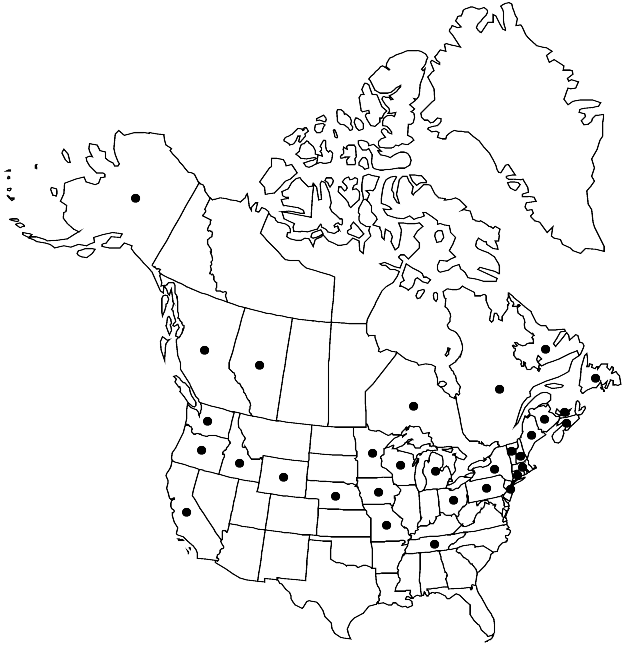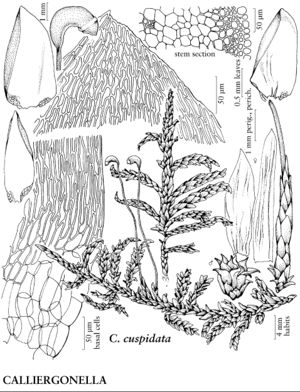Calliergonella cuspidata
Hedwigia 50: 248. 1911.
Plants to 7 cm, in loose tufts or mats. Stems erect, semierect, or decumbent, terete-foliate, pinnate when erect, irregularly branched when decumbent, flattened in cross section, usually turgid at stem and branch apices; outer cortical cells in 3 or 4 layers, inner cortical cells large, walls thin; pseudoparaphyllia foliose; axillary hair basal cell 1, short, brown. Stem leaves ovate, short, broad; apex acute and weakly cuspidate to rounded; costa double, short, usually inconspicuous, or ecostate; supra-alar cells often ± quadrate, walls thicker than those of alar cells; inner basal laminal cells short-elongate, walls thick, pitted; apical cells short, weakly sinuate. Branch leaves lanceolate, longer; apex usually cuspidate; ecostate or costa double, short; alar region ± auriculate. Perigonia axillary, budlike, apex flaring. Perichaetia axillary, inner leaves long-lanceolate, plicate, margins weakly serrate basally, apex flaring at archegonial maturity, ecostate. Seta long, ± erect. Capsule with exothecial cells collenchymatous; annulus differentiated, 2–4-seriate; operculum conic-apiculate; exostome teeth with external surface striolate basally, papillose distally; endostome basal membrane high, segments keeled, perforate. Spores finely punctate.
Habitat: Calcareous wetlands, moderately rich fens, among sedges, lake margins, roadside ditches, weed in lawns
Elevation: low to high elevations
Distribution

Alta., B.C., N.B., Nfld. and Labr., N.S., Ont., P.E.I., Que., Alaska, Calif., Conn., Idaho, Iowa, Maine, Mass., Mich., Minn., Mo., Nebr., N.H., N.J., N.Y., Ohio, Oreg., Pa., Tenn., Vt., Wash., Wis., Wyo., Mexico, South America, Europe, Asia, n Africa, Atlantic Islands (Iceland, Macaronesia), Pacific Islands (New Zealand), Australia (including Tasmania), introduced in West Indies (Jamaica).
Discussion
As emphasized by L. Hedenäs (1990), Calliergonella cuspidata shares with Hypnum lindbergii features such as similar appendiculate endostome cilia, not or slightly denticulate stem and perichaetial leaves, hyaline alar cells in a well-defined group, broad and obtuse pseudoparaphyllia, and a plicate capsule wall when dry; both species group together in molecular phylogenies (M. S. Ignatov et al. 2006; H. Tsubota et al. 2002; A. Vanderpoorten et al. 2002). Plants of C. cuspidata are highly variable, like many wetland mosses. The typical semierect, pinnate habit is developed where the water table is high, while decumbent, irregularly branched habits are found in wetlands where the water table fluctuates. Oddly, plants of mesic lawns are often semierect and pinnate.
Calliergonella cuspidata occurs widely in the Northern and Southern hemispheres; in the United States, particularly in the Pacific Northwest and California and in the Northeast, the species is established commonly on managed residential lawns and in those of cemeteries. In these regions its native habitat and range are not entirely clear. The species is naturalized in Jamaica in plantations. Sporophytes are rare, even when male and female plants grow together, as in northern Michigan.
Selected References
None.
